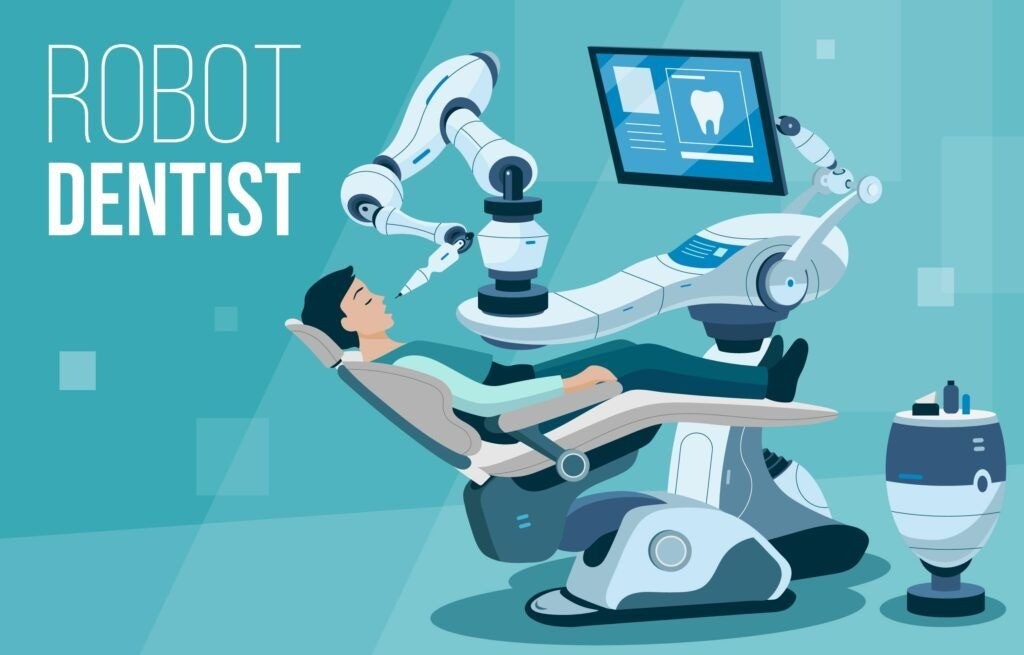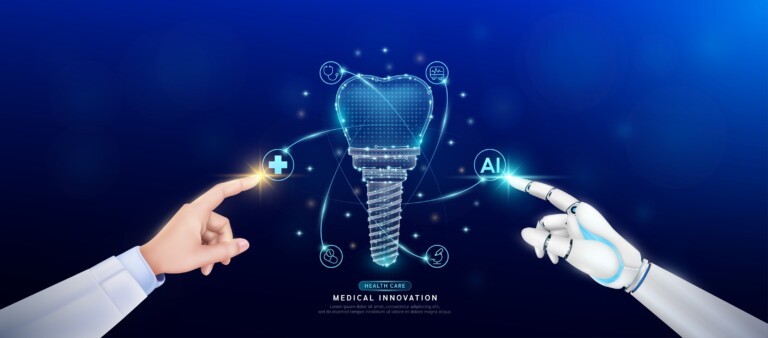AI can do research, automate tasks, create images, write essays, and we still have only begun to scratch the surface of what might be possible with the evolving technology. Most of us have grown used to the idea of AI as a creative and academic tool used to make basic tasks easier and faster.
But how comfortable would you be with AI doing procedures on your patients? Or, for that matter, if AI was in charge of the dental drill in your own mouth?
Recently, Perceptive, an AI company with a focus on dentistry, has made a huge leap forward in AI-assisted technology which marks a significant milestone in dental care. Perceptive has successfully completed the world’s first fully automated dental procedure on a human using an AI-driven robotic system. This pioneering feat is poised to revolutionize dental practices, enhancing precision, efficiency, and patient care.

The Rise of Perceptive in AI and Dentistry
Perceptive is at the forefront of integrating artificial intelligence (AI) with dental practices. The company’s mission is to create intelligent systems that can assist and enhance the capabilities of dental professionals. By leveraging AI, Perceptive aims to improve diagnostic accuracy, treatment outcomes, and patient experiences.
AI dentistry is not entirely new; it has been used for various purposes such as diagnostic imaging, patient management, and treatment planning. However, Perceptive’s latest achievement takes AI application to a new level by utilizing robotic systems for performing actual dental procedures.
The Breakthrough: A Fully Automated Dental Procedure
The world’s first fully automated dental procedure performed by Perceptive’s AI-driven robotic system involved a complex dental drilling process. The procedure was executed without human intervention, demonstrating the remarkable capabilities of AI and robotics in dentistry.
The robotic system used by Perceptive was designed to handle intricate dental tasks with high precision. It was equipped with advanced sensors, cameras, and AI algorithms that allowed it to analyze the patient’s dental structure in real-time. The system could make adjustments on the fly, ensuring optimal outcomes.
“We’re excited to successfully complete the world’s first fully automated robotic dental procedure,” said Dr. Chris Ciriello, CEO and Founder of Perceptive. “This medical breakthrough enhances precision and efficiency of dental procedures, and democratizes access to better dental care, for improved patient experience and clinical outcomes. We look forward to advancing our system and pioneering scalable, fully automated dental healthcare solutions for patients.”
How It Works
Perceptive’s robotic system is a blend of sophisticated hardware and cutting-edge software. Here’s a closer look at how it operates:
- 3D Imaging and Analysis: The process begins with capturing high-resolution 3D images of the patient’s dental structure. These images are analyzed by the AI to create a detailed map of the area to be treated.
- Planning and Simulation: The AI system then develops a comprehensive treatment plan. This plan is simulated multiple times to ensure accuracy and effectiveness. The simulation helps in identifying potential issues and making necessary adjustments before the actual procedure.
- Execution: During the procedure, the robotic arm, guided by the AI, performs the necessary dental tasks. The system’s precision is unmatched, capable of drilling with micrometer accuracy. The AI continuously monitors the process, making real-time adjustments to ensure safety and efficacy.
- Post-Procedure Analysis: After completing the procedure, the system conducts a thorough analysis to confirm that the desired outcomes have been achieved. Any deviations are documented, and the data is used to improve future performance.
Implications for Dental Professionals
The successful completion of this automated procedure has far-reaching implications for dental professionals. Here are some key benefits and considerations:
- Enhanced Precision and Consistency: AI-driven robotic systems can perform procedures with a level of precision that is difficult to achieve manually. This consistency can lead to better patient outcomes and reduced likelihood of errors.
- Efficiency and Time Management: Automated systems can perform repetitive and time-consuming tasks more quickly than human dentists. This can free up valuable time for dental professionals, allowing them to focus on more complex cases and patient care.
- Access to Advanced Care: In areas where access to specialized dental care is limited, AI-driven systems can provide high-quality care. This can help bridge the gap in dental health disparities.
- Training and Education: Dental schools and training programs can use AI and robotic systems to enhance education. Students can learn from simulations and practice on virtual models before working on real patients.
- Patient Experience: Patients may experience less anxiety knowing that procedures are being performed with high precision and minimal human error. The efficiency of automated systems can also reduce the time spent in the dental chair.
Challenges and Ethical Considerations
This use of AI has many of the same ethical questions that get raised by other forms of AI. While the advancements brought by Perceptive’s technology are impressive, there are challenges and ethical considerations to address. The initial cost of implementing AI-driven robotic systems can be high, making it crucial to ensure that these technologies are accessible to a wide range of dental practices, especially smaller ones. Developing standardized protocols and regulatory frameworks for the use of AI in dentistry is essential to ensure patient safety and the consistent quality of care.
Despite the capabilities of AI, human oversight remains important; dental professionals must be trained to work alongside AI systems and intervene when necessary. Additionally, protecting patient data is paramount, and robust cybersecurity measures must be in place to safeguard sensitive information.

The Future of AI in Dentistry
The successful completion of the world’s first fully automated dental procedure is just the beginning. The future of AI in dentistry holds immense potential. Here are some trends to watch:
Personalized Treatment Plans
AI can analyze vast amounts of data to develop personalized treatment plans tailored to individual patients. This can improve the effectiveness of treatments and patient satisfaction.
Predictive Analytics
AI can predict dental issues before they become severe, allowing for early intervention and preventive care.
Remote Dentistry
AI-driven systems can enable remote consultations and treatments, making dental care more accessible to people in remote areas.
Integration with Other Technologies
Combining AI with other technologies such as virtual reality (VR) and augmented reality (AR) can enhance dental education and patient engagement.
The Future of AI-Driven Dentistry
Perceptive’s groundbreaking achievement in completing the world’s first fully automated dental procedure using an AI-driven robotic system marks a significant milestone in the evolution of dentistry. This innovative technology promises to enhance precision, efficiency, and patient care, paving the way for a future where AI and robotics play a central role in dental practices. As we embrace these advancements, it is crucial to address the challenges and ethical considerations to ensure that the benefits of AI-driven dentistry are realized for all. The future of dentistry is bright, and with continued innovation, we can look forward to a new era of dental care that is more accurate, efficient, and accessible than ever before.
While this type of AI product may be a long way off becoming the standard in the majority of US practices, diagnostic tools like Overjet AI are seeing much faster adoption rates due to their accessible cost, and the ease of implementation into your practice’s existing workflow.
For more information on cutting advancements in digital dentistry and the most advanced tools that are available for your practice today, contact a Benco Dental equipment specialist or schedule a visit to one of the CenterPoint Showrooms to see new technology in action.




